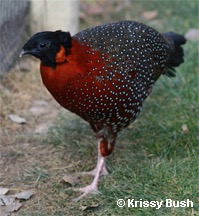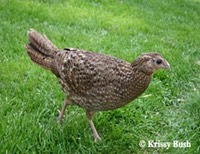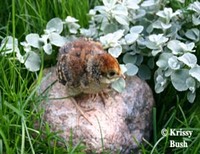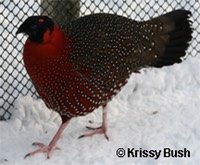Scientific Information
Class: Aves
Order: Galliformes
Family: Phasianidae
Subfamily: Phasianinae
Genus: Tragopan
Species: satyra
Species English name: Satyr Tragopan
CITES Status: CITIES III - vulnerable
Distribution: Central & Eastern Himalayas
(from A Monograph of Pheasants Volumes I & II, William Beebe)
Description
• Male - Black head, face, and throat, blue wattles, red neck, chest, & stomach (lower down the body, white and black circular spots appear on the feathers). Back and wings are brown with white and black spots, brown and black tail, grey beak, and pink legs
• Female - Brown with creamy spots over most of the body, creamy face, creamy bars on tail. Creamy pink legs and grey beak.
Diet
• We feed our breeders and young adults 16% layer pellets, our tiny chicks 25% Turkey Starter crumble, and our growing chicks 20% crumble.
• Satyrs are big treat lovers. They get a handful of mixed grains every second day except during breeding season, fresh greens (lettuce, chickweed, dandelions, grass) and fruits (tomato, grapes, berries, etc.) when available. They also love mealworms.
Breeding
• Done in pairs. Tragopans are very monogamous birds and become very attached to their mate.
• Satyrs are second year birds meaning that the female will not lay eggs and the male is not fertile until their second year. We have had females lay a few eggs in their first year though.
• They start laying eggs around mid April and will lay every second day until they lay approximately 10 eggs.
• They lay very large roundish splotchy eggs.
Incubation
• Eggs are collected twice a day and marked with the date and breeding pen number and set daily.
• Eggs are set in an automatic turning Lyons Roll-X (RX2) with grid 71
• Temperature 99.8°F, humididty-wet bulb 80 with humidity adjusted periodically depending on development of the air space shown by candling
• On the final day of incubation, each egg is placed in its own oval wire mesh hatching basket (6" x 3" x 3") and set in the Sportsman Rattite hatcher.
• Incubation for Satyr Tragopans is 28 days.
• After the chick hatches, it stays in the hatcher for a minimum of 8 hours.
Chicks
• Chicks have a cream belly and throat with brownish-red back, wings, and head.
• They start out in our round 18" brooder pen with a mixed assortment of chicks. After a few days they are separated into a 2' x 4' baby pen for about a week. They are then transferred to an all Tragopan 2' x 6' pen for the next 7-9 weeks. They stay with this grouping until they are sold. All of these brooding pens have wire bottoms with a heat lamp at one end and feed & water at the other end. The heat lamp is attached to a dimmer switch so we can turn down the amount of heat as the chicks get older until it is turned off completely.
• After they are off of the heat for a few weeks, they are moved outside to the pheasant house (has outside grassy pens and a heated inside house part where they are blocked in for the night). After they are toughened up, they are moved to an outside chick pen.
• Chicks are very easy to raise together with their own kind. You can mix quite a variety of ages and sexes without problems.
Pens
• 25' long x 10' wide x 6' high with a 4' x 4' x 4' house in the middle.
• Pens are covered with 2" diamond top-rite.
• 1 Tragopan Hut (1' x 1' x 1' high) on stilts containing straw on top of the house for laying eggs.
• Pens contain grass, but need to be mowed since Tragopans are moderate grass eaters.
• See Scintillating Copper Article for predator proofing set-up
Behavior
• Are calm and relatively quiet birds. Males will puff up their bodies during the breeding season, reveal fleshy blue horns, and unravel their blue throat skin with purple and red accents.
• They are very easy to tame down and are incredibly friendly and curious birds.
• The males can become aggressive enough to attack humans during breeding season.
Article By Krissy & Donna Bush
Pheasant Ridge



